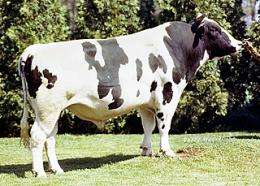Pawnee Farm Arlinda Chief, one of the most important stud bulls in the Holstein breed. Sequencing Chief's genome is giving new insight into cattle breeding. Credit: Danny Weaver, Agri-Graphics Ltd.
(Phys.org) -- With more than 60,000 descendants in six generations, Pawnee Farm Arlinda Chief and his son Walkway Chief Mark cast a long genetic shadow. New research on the genomes of the two bulls show how portions of their DNA that control important traits such as disease resistance or milk production have spread throughout the contemporary Holstein breed, the world’s highest-producing dairy animal.
The research, published online April 23 in Proceedings of the National Academy of Sciences, may provide for faster and less costly methods to breed genetically elite cattle.
"The technique we developed, called ‘haplotracking,’ allows researchers to identify chromosome segments that are under selection in a certain population and match them with genes controlling specific traits," said Harris Lewin, senior author of the paper, who led the research project while at the University of Illinois Urbana-Champaign. Lewin is now vice chancellor for research at the University of California, Davis.
The cattle genome research offers a window into evolution, showing how selection affects genes that control complex traits like resistance to infectious diseases, Lewin said.
Chief, born in 1962, and Mark, born in 1978, each account for about 7 percent of the genomes of the current North American Holstein cow population, according to research published previously by the U.S. Department of Agriculture. The new study allows researchers to track specific genes in the population.
"These were two of the greatest bulls in the history of the Holstein breed," Lewin said.
Lewin and his colleagues sequenced the genomes of both bulls, identifying more than one million single-nucleotide polymorphisms. These changes, known as SNPs, occur when a single letter of the genetic code is changed. The researchers used this information to identify haplotypes, or stretches of DNA, that Chief and Mark had passed down to their descendants intact.
Within these haplotypes, the researchers identified genes and SNPs related to fertility, milk yield and virus resistance – all traits that could potentially and significantly augment the economic viability of a dairy cattle-breeding operation or dairy farm.
Dairy cattle have been under intense selection for economically important traits such as milk yield and milk fat for more than a half-century, resulting in large databases of production data and DNA samples – much more information than is available for human populations. The comparative wealth of genetic information about cattle, especially the ability to reconstruct and track individual haplotypes, may prove vital in understanding the genetic basis for complex traits in both human and other animal populations, Lewin said.
Journal information: Proceedings of the National Academy of Sciences
Provided by UC Davis





















